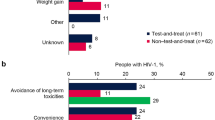Abstract
This paper is a discussion of “Surrogate Endpoints in AIDS Drug Development: Current Status” by C. Chuang-Stein and R. DeMasi which appears in this issue of the Drug Information Journal. The authors argue that demonstrating HIV-1 RNA reduction and CD4+ cell count increase together constitute operationally acceptable evidence that a treatment would demonstrate a significant clinical benefit if a clinical endpoint trial were carried out. This argument is based primarily on findings from trials of treatments with modest effects. Evidence from recent trials of more potent agents suggest that this concept may not be unreasonable. The issue, however, is not whether this should be done, but rather just how information about viral load reduction and CD4+ cell count increase should be used either to manage patients or to draw conclusions about a drug’s likely clinical benefit. In particular, it seems unlikely that finite courses of treatment will be sufficient, and that the effectiveness of a treatment will be defined in terms of its ability to sustain long-term suppression of viral load below levels detectable with sensitive assays.
Similar content being viewed by others
References
Feinberg MB. Changing the natural history of HIV disease. Lancet. 1996;348:239–246.
Fleming TR, DeMets DL. Surrogate endpoints in clinical trials: Are we being misled? Ann Int Med. 1996;125:605–613.
Prentice RL. Surrogate markers in clinical trials: Definition and operational criteria. Stat Med. 1989;8:431–440.
DeGruttola V, et al. Perspective: Validating surrogate markers—Are we being naive? J Infectious Dis. 1997;175:237–246.
Lin DY, Fleming TR, DeGruttola V. Estimating the proportion of treatment effect explained by a surrogate marker. Stat Med. 1997;16:1515–1527.
Daniels MJ, Hughes MD. Meta-analysis for the evaluation of potential surrogate markers. Stat Med. 1997;16:1965–1982.
Mellors JW, et al. Plasma viral load and CD4(+) lymphocytes as prognostic markers of HIV 1 infection. Ann Int Med. June 15, 1997;126:946–954.
Feinberg MB. Hidden dangers of incompletely suppressive antiretroviral therapy (Commentary). Lancet. May 17, 1997;349:1408–1409.
Wong JK, et al. Recovery of replication-competent HIV despite prolonged suppression of plasma viremia. Science. November 14, 1997;278:1291–1295.
Finzi D, et al. Identification of a reservoir for HTV-1 in patients on highly active antiretroviral therapy. Science. November 14, 1997;278:1295–1300.
Condra JH, Schlief WABOM, et al. In vivo emergence of HIV-1 variants resistant to multiple protease inhibitors. Nature. 1995;374:569–571.
Raboud JM, et al. Variation in plasma RNA levels, CD4 cell counts, and p24 antigen levels in clinically stable men with human immunodeficiency virus infection. J Infect Dis. July 1996;174:191–194.
Deeks SG, et al. Variance of plasma human immunodeficiency virus type 1 RNA levels measured by branched DNA within and between days. J Infect Dis. August 1997;176:514–517.
Author information
Authors and Affiliations
Rights and permissions
About this article
Cite this article
Lawrence Gould, A. Discussion of “Surrogate Endpoints in Aids Drug Development: Current Status” by C. Chuang-Stein and R. Demasi. Ther Innov Regul Sci 32, 453–456 (1998). https://doi.org/10.1177/009286159803200217
Published:
Issue Date:
DOI: https://doi.org/10.1177/009286159803200217




